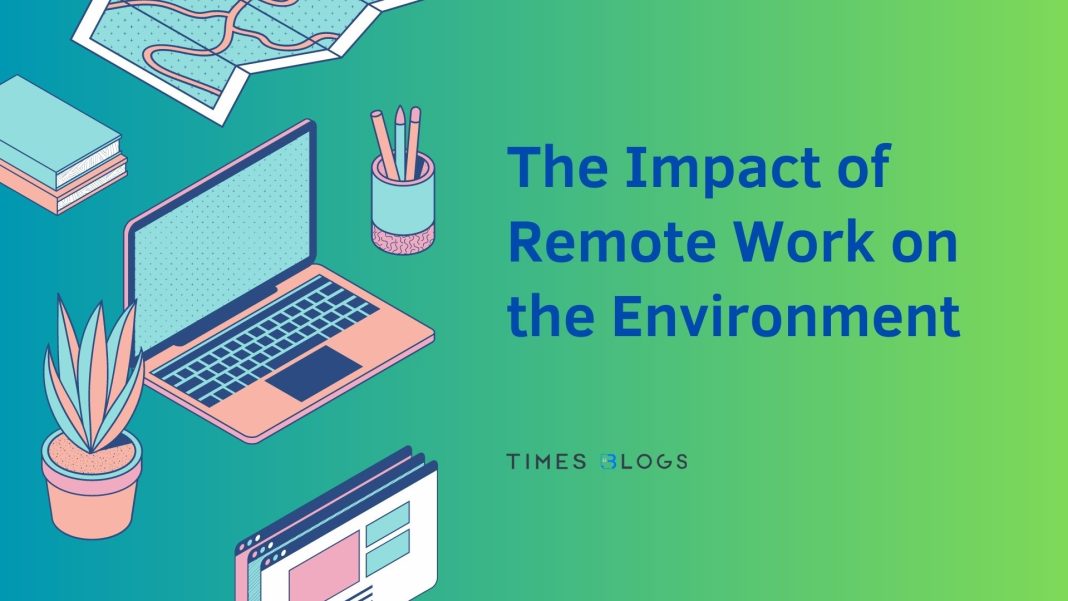Remote work is becoming increasingly popular (Remote Work Statistics), with more and more companies offering their employees the option to work from home. The COVID-19 pandemic has accelerated this trend, with many people working remotely due to social distancing measures. While remote work has many benefits, including improved work-life balance and reduced commuting times, there are also environmental impacts to consider. In this blog, we will explore the impact of remote work on the environment, including the positive and negative effects.
Table of Contents
Positive Impact:
Reduced Carbon Emissions
One of the biggest benefits of remote work is the reduction in carbon emissions. Commuting to work is a major source of carbon emissions, with cars and public transport being major contributors. By working from home, employees can reduce their carbon footprint by eliminating or reducing their commute. This reduction in carbon emissions is good news for the environment, as it helps to mitigate the effects of climate change.

For example, the software company Buffer estimates that their remote team saved 4,900 metric tons of CO2 emissions in 2020 by not commuting to work. Similarly, the tech company Shopify reports that their remote workforce saved an estimated 23,000 metric tons of CO2 emissions in 2020 by working from home.
Reduced Energy Consumption
Another positive impact of remote work is the reduction in energy consumption. When employees work from home, they do not need to use office equipment and facilities, such as lights, heating, and air conditioning. This reduction in energy consumption helps to conserve resources and reduces the demand for fossil fuels, which are major contributors to greenhouse gas emissions.

For example, the consultancy firm Deloitte reports that their remote workforce reduced energy consumption by an estimated 135,000 kWh in 2020. Similarly, the insurance company Aetna reports that their remote workforce reduced energy consumption by an estimated 27 million kWh in 2020.
Reduced Waste
Remote work can also lead to a reduction in waste. When employees work from home, they are less likely to use disposable cups, plates, and cutlery, as well as other single-use items that are commonly found in offices. Additionally, remote work can lead to a reduction in paper usage, as employees can share documents digitally and use electronic signatures.

For example, the tech company Zapier reports that their remote workforce reduced paper usage by an estimated 10,000 pages in 2020. Similarly, the digital agency ConvertKit reports that their remote workforce reduced waste by an estimated 4,500 pounds in 2020.
Reduced Commuting Emissions
One of the most significant environmental benefits of remote work is the reduction in commuting emissions. With fewer people commuting to and from work, there is a corresponding reduction in greenhouse gas emissions from cars, buses, and trains. This reduction in emissions can help to improve air quality, reduce traffic congestion, and mitigate the negative impacts of climate change.
Reduced Office Energy Usage
Remote work can also lead to a reduction in energy usage in office buildings. With fewer employees working in the office, there is less need for lighting, heating, cooling, and other energy-intensive systems. This reduction in energy usage can help to reduce carbon emissions and lower energy costs for companies.
Reduced Paper Usage
Remote work can also help to reduce paper usage in the workplace. With digital communication tools and online collaboration platforms, employees can share and collaborate on documents without the need for printing. This reduction in paper usage can help to conserve natural resources, reduce waste, and lower the carbon footprint of companies.
Increased Awareness of Environmental Issues
Remote work can also help to increase awareness of environmental issues among employees. With more time spent at home, employees may be more likely to adopt eco-friendly habits, such as reducing waste, conserving water, and using energy-efficient appliances. Additionally, remote work can provide opportunities for companies to educate their employees on sustainability issues and promote environmentally responsible behavior.
Increased Adoption of Renewable Energy
Finally, remote work can help to increase the adoption of renewable energy sources. With more companies investing in sustainable infrastructure and renewable energy, remote work can provide a platform for companies to showcase their commitment to sustainability and promote the adoption of renewable energy sources. This can help to accelerate the transition to a low-carbon economy and mitigate the negative impacts of climate change.
Negative Impact:
Increased Energy Usage
While remote work can lead to a reduction in energy consumption, it can also lead to an increase in energy usage. When employees work from home, they need to use their own electricity and internet, which can increase their energy consumption. Additionally, remote work can lead to the use of personal devices, such as laptops and smartphones, which may not be as energy-efficient as office equipment.
For example, a study conducted by the University of California, Berkeley found that remote work led to an increase in residential energy consumption of 3% to 30%, depending on the region. Similarly, a study conducted by the consulting firm Accenture found that remote work led to an increase in IT energy consumption of up to 25%.
Increased E-Waste
Remote work can also lead to an increase in e-waste. When employees use personal devices for work, they may need to upgrade their devices more frequently, leading to a higher rate of obsolescence. Additionally, remote work can lead to the use of personal devices for work purposes, which may not be as durable as office equipment and may need to be replaced more frequently.
For example, a study conducted by the United Nations found that the amount of e-waste generated globally is expected to reach 74 million metric tons by 2030, with a significant portion of this waste coming from the increased use of personal devices. This e-waste poses a significant environmental risk, as it contains hazardous materials that can harm both human health and the environment.
Increased Water Usage
Remote work can also lead to an increase in water usage. When employees work from home, they may use more water for household tasks, such as cooking and cleaning, which can contribute to increased water usage. Additionally, remote work can lead to the use of personal devices, which require water in their production.
For example, a study conducted by the consulting firm Accenture found that remote work led to an increase in water usage of up to 14%. Similarly, a study conducted by the tech company HP found that the production of personal devices, such as laptops and smartphones, accounted for up to 70% of the water footprint of the IT industry.
Increased Home Energy Usage
While remote work can lead to a reduction in energy usage in office buildings, it can also lead to an increase in home energy usage. With employees working from home, there is an increased demand for heating, cooling, lighting, and other energy-intensive systems in residential buildings. This increase in home energy usage can lead to higher carbon emissions and higher energy costs for employees.
Increased Digital Infrastructure
Remote work can also lead to an increase in digital infrastructure, such as data centers, servers, and communication networks. These digital infrastructures require significant amounts of energy to operate, and their growth can lead to an increase in carbon emissions and energy consumption.
Reduced Social Interaction
Remote work can also lead to a reduction in social interaction, which can have negative impacts on mental health and well-being. This reduction in social interaction can also lead to an increase in loneliness and isolation, which can lead to negative environmental impacts, such as a decrease in pro-environmental behavior.
Increased Shipping Emissions
Remote work can also lead to an increase in shipping emissions, as employees may need to order products and supplies online more frequently. This increase in shipping emissions can lead to higher carbon emissions and an increase in the use of non-renewable resources.
Increased Land Use
Finally, remote work can also lead to an increase in land use. With more employees working from home, there may be an increased demand for residential buildings, which can lead to an increase in land use and a reduction in natural habitats. Additionally, remote work can lead to an increase in urban sprawl, which can further exacerbate these negative impacts.
Mitigation Strategies:
Implement Sustainable Work Practices
To mitigate the negative impacts of remote work, companies can implement sustainable work practices, such as encouraging employees to use energy-efficient devices and appliances, using renewable energy sources, and promoting the use of digital documents and communication tools.
For example, the tech company Cisco has implemented sustainable work practices, such as using renewable energy sources for their data centers and promoting the use of teleconferencing and other digital communication tools to reduce travel.
Support Sustainable Development
Companies can also support sustainable development by investing in renewable energy and sustainable infrastructure, as well as supporting initiatives that promote sustainable development and conservation.
For example, the tech company Apple has invested in renewable energy, including wind and solar power, and has committed to achieving 100% renewable energy for their global operations. Additionally, the company has implemented sustainability initiatives, such as recycling programs and the use of recycled materials in their products.
Promote Sustainable Behavior
Companies can also promote sustainable behavior among their employees, such as encouraging them to use public transportation, cycling or walking instead of driving, and promoting eco-friendly habits, such as reducing waste and conserving water.
For example, the software company Atlassian has implemented a program that encourages employees to use public transportation, offering subsidies for public transportation and bike-sharing programs, as well as promoting carpooling and the use of electric vehicles.
Current Stats
- According to a study by Global Workplace Analytics, if employees who are able to work remotely worked from home half of the time, it could reduce greenhouse gas emissions by over 54 million metric tons per year.
- The same study found that if the U.S. workforce worked from home just one day per week, it could reduce greenhouse gas emissions by 20 million tons per year – the equivalent of taking 2 million cars off the road.
- In a survey by Owl Labs, 62% of remote workers reported that they were able to reduce their carbon footprint by working remotely, with 92% of respondents saying that remote work is environmentally friendly.
- A report by the Carbon Trust found that companies can reduce their carbon footprint by up to 30% by implementing remote work policies.
- A survey by PwC found that 83% of executives believe that remote work is here to stay, with many citing its positive impact on the environment as a reason to continue remote work policies.

While these statistics demonstrate that remote work can have a positive impact on the environment, it is important to note that the impact of remote work on the environment can vary depending on factors such as the industry, the location of employees, and the policies and practices of companies.
Conclusion
Remote work has the potential to have a significant impact on the environment, both positive and negative. While remote work can reduce greenhouse gas emissions, air pollution, and other negative environmental impacts associated with commuting and traditional office-based work, it can also lead to increased energy usage, increased digital infrastructure, and reduced social interaction.
Companies can play a critical role in promoting sustainable remote work practices and mitigating the negative impacts of remote work on the environment. By implementing sustainable policies and practices, such as encouraging employees to use energy-efficient technologies and promoting sustainable transportation options, companies can help to reduce the negative impacts of remote work on the environment. Additionally, by promoting sustainable behavior among employees, such as encouraging them to reduce their energy usage and to use sustainable products and services, companies can help to ensure that remote work is environmentally responsible.
Overall, the environmental impact of remote work is complex and multifaceted, and it is important for companies, employees, and policymakers to continue to explore ways to promote sustainable remote work practices and to mitigate the negative impacts of remote work on the environment. By working together, we can ensure that remote work is not only a viable and effective way of working but also a responsible and sustainable one.




